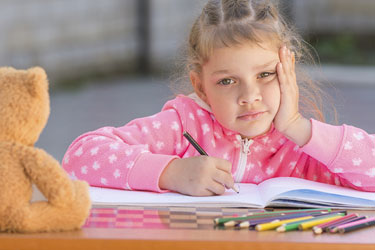Benefits of Anxiety Art
Anxiety Art is a powerful strategy for building resilience in kids. Today, anxiety is one of the most prevalent children’s mental health issues with the average age of onset for anxiety disorders being 6 years of age (Merikangas et al., 2010). Anxiety consists of many specific disorders including panic, OCD, specific phobias, PTSD, and social, separation, and generalized anxiety. When dealing with trauma we are often dealing with symptoms of Post-Traumatic Stress Disorder, which is an anxiety disorder. Our treatment plans will likely, at some point, need to address issues of anxiety.
Regardless of type of anxiety disorder, what matters in treatment is the process that happens, not so much the content of the worry. Whether the child is having worries about tripping in front of her class, seeing spiders, or needs to check the locks on the house six times before leaving, the mechanism at work is the same. The child is avoiding situations that: bring up feelings of uncomfortableness and uncertainty; is looking for reassurance; parents reassure and reassure again; it is not enough; and worries spiral out of control. We need to intervene to address the process, which is to empower the child to take charge of these worries. No one can do it for them.
There are many resources available to clinicians and families who are supporting children with anxiety (see resource list below this blog). One of the first steps in dealing with anxiety is externalizing the issue and relabeling anxiety (Chansky, 2004; Clark & Garland, 2009; Peters, 2013; and Wilson & Lyons, 2013). This is where anxiety art comes into play. Everything from taming your worry dragons, to squishing your worry bugs, to standing up to your worry monsters, are identified as ways to help children take charge of their fears and worries that are often interfering with their day to day life (Image 1).
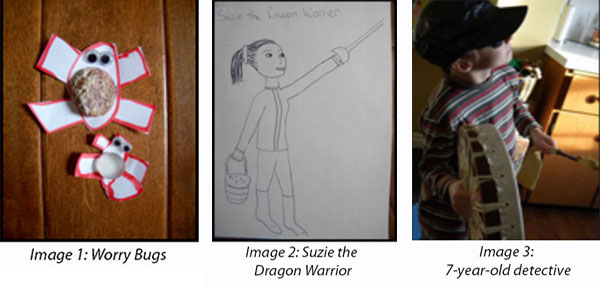
For years I have been working with children, their families, and anxiety. Early on in my work, a 10-year-old girl taught me about being a warrior rather than a worrier (Image 2). This is such a great idea and one that is now in book form (Peters, 2013). In keeping with this theme, we will explore further how warriors can be supported with the arts. The following section highlights a range of expressive arts-based interventions that can be combined with a comprehensive treatment approach to dealing with anxiety in children.
Become the Experts – Detectives
Families are invited to rally against the worry by becoming experts in the tricks of worry. If we embody the detective we are not judging the child, but rather we are all on the same team supporting the child as cheerleaders believing in the power he/she has in standing up to the worries. We are all detectives, meaning we are curious; we are looking for signs of strength; for times when the child outsmarts worry; and we are looking for what makes worry become smaller or the child become more powerful. This gives the child the felt experience that he/she is not alone in what can seem like a very overwhelming world (Image 3).
Show Me the Worry
As with any presenting issue, it is important to know how the child experiences the issue from their personal point of view. This is no different than inviting children to show us the hurt, the sadness, the trauma. We invite the child to make us witness to the experience. We can then begin to see and understand from their point of view how they live with anxiety day to day. We don’t need to label anxiety art. We simply need an outlet for children to answer our questions:
- What does worry look like? Feel like? How big is it compared to you? (Image 4)
- How do you think your mom and dad see you and worry?
- How do mom and dad see their child and worry?
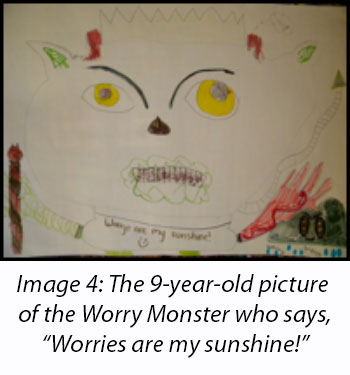
Once we have the images, we can be curious about stories that may go with the image and/or characters. We can enact the story by cutting out the characters, use puppets, or dress up. We can further bring them to life by giving voices to the characters.
Stories have the potential to lead us further into the inner world of the child and their life with anxiety. Through this process we may discover unique resources that this child could utilize in their treatment process.
Facing the Avoider
Whatever kinds of anxiety children are dealing with, the Avoider will inevitably be part of the work. The Avoider is worry’s best ally. It shows up in so many different ways, but its job is to do one thing – avoid feeling discomfort and uncertainty.
Children can also show us the Avoider. What does it look like? How do they work together? What tricks do they have up their sleeve? Create a story about worry and the Avoider. What kind of outcome do you want for this story?
Taming Tricky Thoughts
Comic strips are effective anxiety art choices for kids to capture tricky thoughts and to find ways to talk back to these thoughts. Images 5 – 7 show only three of ten images created by a 15-year-old boy who used his story about worry to walk through therapeutic steps needed to conquer his fears and the tricky thoughts that created the worries.

Body Chillers for Jitters
There are many videos available for children and parents to watch to help them deal with the various aspects of anxiety. “Belly Breathe” by Sesame Street is a catchy video and song and a fun way for kids to learn the art of belly breathing.
Creating their own movement sequence can also be an empowering way for children to work with their own imagination, energy, and inner knowing to create meaningful ways to calm themselves and remember their resources. The 10-year-old girl who painted the wooden box below (Image 8), identified four phrases to help her with severe performance anxiety. Her four phrases were: Be Brave, Trust Myself, You Know How to Do This, and You Can Do This. She then created a dance/movement sequence to go with each phrase to help her remember these powerful words. She would practice her sequence on the days when she would perform.
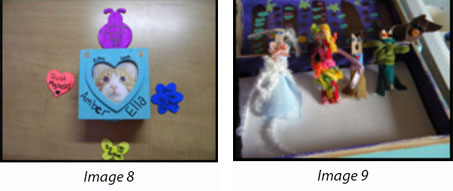
Strength Training: Building Brave Muscles (AKA Resources)
The best way to conquer worry is to build brave muscles. Kids don’t tend to know just how brave they are and how important being brave is to worry-busting. The only way to deal with worries and fears is to FACE them—and that doesn’t necessarily require anxiety art. The following are some ideas about how kids and families can build their brave muscles.
Play List for Warriors
Create two play lists. The first play list consists of music that calms and soothes when time outs are needed and soothing the body and mind is a priority. Sometimes warriors need a little more energy to muster up their bravery to face what they don’t want to face. Create a second play list when warriors are needing extra energy to motivate them to be brave. Work with them to identify songs that inspire, give energy, and lyrics that help them believe in their brave.
Brave Jars
Each time someone in the family sees an act of bravery they can add a stone into the jar with a word on it.
Power Figures vs. Worry Dolls
Worry dolls are commonly known and used to help kids with worries. The idea, from the Guatemalan legend, is that children tell a worry doll their worry at night and put the doll under the pillow, and the worry doll magically takes it away. What I have found even more powerful has been to create power figures. The invitation is for children to think about creating a figure that represents their power and/or strength to face their worry. For example, one child created a set of five figures (Image 9), each one represents either a part of herself (her courage, her inspiration and her wise self) or someone else who helps her develop brave muscles (her mother and her dog).
Image 10 was created by a 10-year-old boy who created Gandalf, the wizard, to remind him that he is not alone and that he too has strong inner powers to stand up to his fears. The imagination truly has no limits.
Anti-Anxiety Power Props
Sunglasses, hats, capes, and wands. Every warrior needs special combat props and each child will be different in terms of what makes sense to them. They can make a special tool box or tool belt to use to deal with a variety of worries, fears, and tricks.
Wands can be especially decked out with gadgets and powers that only a child’s mind could conjure up to help them with their unique situation (Image 11). Special glasses can be used when warriors are needing to practice looking more at the positive sides to things or when they are needing “learning to be grateful” glasses to assist them.
Whatever anxiety art modality is used, we must embed the intervention in an overall comprehensive treatment plan. There is no limit to the imagination, in particular, when we tap into the minds of children and teens, who inherently know their own strengths, but need support with creating space for those strengths and resources to emerge. It is then that children can truly embody the warrior within.
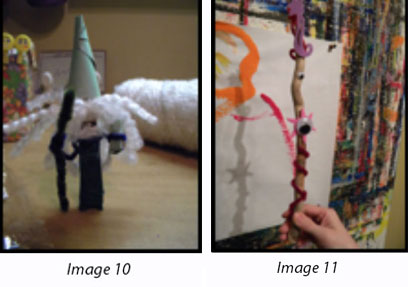
REFERENCES
Chansky, T. (2004). Freeing your child from anxiety. New York, NY: Broadway Books.
Clark, S. & Garland, J. (2009). Kid’s guide to taming worry dragons.
Peters, D. (2013). From worrier to warrior: A guide to conquering your fears. Tucson, AZ: Great Potential Press.
Wilson, R. & Lyons, L. (2013). Anxious kids anxious parents: 7 ways to stop the worry cycle and raise courageous & independent children. Deerfield Beach, FL: Health Communications, Inc.
Merikangas, K., Hep, J., Burstein, M., Swanson, S., Avenevoli, S., Cui, L., Benejet, C…Swendsen, J. (2010). Lifetime prevalence of mental disorders in U.S. adolescents: results from the National Comorbidity Survey Replication–Adolescent Supplement (NCS-A). Journal of American Academy of Child and Adolescent Psychiatry. 49(10): 980-989. doi: 10.1016/j.jaac.2010.05.017
Walkup, J. T., Albano, A. M., Piacentini, J., Birmaher, B., Compton, S. N., Sherrill, J. T., Kendall, P. C. (2008). Cognitive Behavioral Therapy, Sertraline, or a Combination in Childhood Anxiety. The New England Journal of Medicine, 359(26), 2753–2766. doi:10.1056/NEJMoa080463
RESOURCE LIST
WEBSITES:
- Anxiety BC
- ADAA
- Child Mind Institute
- Coping Cat Program www.WorkbookPublishing.com
- KidsHealth.org/kid/
- Turnaround Anxiety Program www.turnaroundanxiety.com
- WorryWiseKids.org
BOOKS:
Anxious Kids, Anxious Parents: 7 Ways to Stop the Worry Cycle and Raise Courageous & Independent Children by Reid Wilson & Lynn Lyons (2013)
Don’t Feed the Worry Bug by Andi Green
Freeing Your Child From Anxiety by Tamar Chansky (2004)
From Worrier to Warrior: A Guide to Conquering Your Fears by Daniel Peters (2013)
Mighty Moe: An Anxiety Workbook for Children http://www.cw.bc.ca/library/pdf/pamphlets/Mighty%20Moe1.pdf
When My Worries Get Too Big: A Relaxation Book for Children who Live With Anxiety (2006) by Kari Dunn Buron | FSRC
This book presents ways for young children with anxiety to recognize when they are losing control and constructive ways to deal with it.
Kid’s Guide to Taming Worry Dragons (2009) by Sandra L. Clark and Jane E. Garland | FSRC
This pocket-sized book provides an overview of taming worry dragons (types of worries, how they affect your body and thoughts, when they come around) as well as a summary of tools for “trapping & taming” worry dragons. Space is available for kids to add their own ideas.
Tools for Taming and Trapping Worry Dragons: Children’s Workbook (2008) by Sandra L. Clark and Jane E. Garland | FSRC
Workbook accompanying Taming Worry Dragons that helps children learn to handle anxiety and distress. These activities help children aged 8-12 years understand anxiety and teach them specific strategies for coping.
What to Do When You Worry Too Much: A Kid’s Guide to Overcoming Anxiety (2006) by Dawn Huebner & Bonnie Matthews | FSRC
This illustrated book guides children and parents through the cognitive-behavioral techniques most often used in the treatment of anxiety. Concepts and strategies are introduced through metaphors and illustrations, which make them easy to understand.

